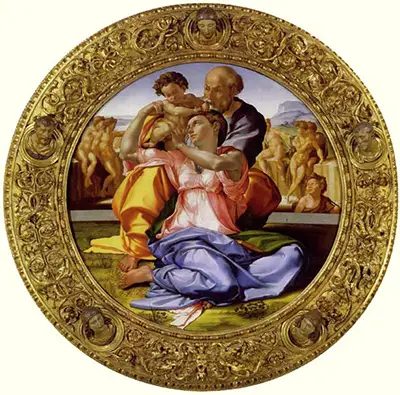Painted on a round wooden panel, the painting was completed in, or around, 1506 and is the only surviving panel painting produced by Michelangelo as a mature artist.
The Holy Family with St. John is believed to have been commissioned by Agnolo Doni, a successful Florentine merchant, and the work is sometimes called “The Doni Tondo”. It is thought that the painting was to be a gift for his wife, Maddalena Strozzi, the daughter of a prominent Tuscan family, possibly on the occasion of their marriage or, perhaps, the birth of their first daughter.
The round, or tondo form of the painting together with the domestic nature of its subject shows that this is a piece intended to be displayed in a home and there is evidence to suggest that this work remained in the Doni’s home until at least 1591.
The painting remains in its original frame and it is possible that, while it is thought to have been carved by Marco and Francesco Del Tasso, Michelangelo may well have contributed to its design. The design includes a number of motifs, including moons and the heads of lions, which, being taken from the coats of arms of the Doni and Strozzi families, symbolise the union of the two families that their marriage represented.
Agnolo Doni and his wife were cultivated collectors of art and commissioned works from the leading artists of their day, including portraits, of each of them, from Raphael. They are also known to have owned works by Donatello and Fra Bartolommeo.
Michelangelo had returned to Florence, from Rome, due to delays to the project to build the tomb of Pope Julius II because of lack of funds. It is likely that he finished this piece before he returned to Rome and began work on the Sistine Chapel in 1508.
The painting shows the Virgin Mary, seated on the ground, turning to receive the Christ child from Joseph as he crouches down behind her. Michelangelo portrays perfectly the loving care the two parents are taking, in this small act of passing the child between them, in both the careful handling shown in their complex pose and in the love and concentration that is shown in their faces.
Behind them a young St John the Baptist is shown in a pool of water that is symbolic of his baptismal role that is to come. In the background a group of naked youths sit looking rather similar to a frieze of classical figures.
There have been many interpretations of this work of Michelangelo. It can be seen simply as an image of a loving family and there can be no doubt that would have been an important aspect of the painting for Agnolo Doni and his young wife.
The nude figures behind are considered by some to be influenced by the classical figures of Laocoön and His Sons excavated in Rome in 1506. These figures could be seen to represent the pagan world. Between these pagan youths and the salvation of Christianity stands only the sacrament of baptism represented by the figure of the young St John the Baptist shown between them and the Holy family.


